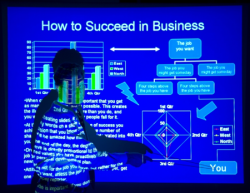PowerPoint is Not the Enemy of Interesting Presentations
For years I have observed the ascendancy of PowerPoint (and similar tools) until now it has become an ever present companion in almost every presentation I attend. Throughout the web you can find sites discussing its overuse with such titles as, “Death by PowerPoint”. In many ways I agree with these writers in that most presenters use it poorly, too much, and as a replacement for their notes. But to blame PowerPoint for the problem is like blaming the hammer because you hit your thumb. The tool is not the problem. The operator is! If that operator is you, here are some practical steps you can take to improve your presentation through the proper use of the PowerPoint tool.
Write Your Presentation in Word – Almost every corporate presenter I work with uses PowerPoint as the platform for writing their presentation. They do this for a couple of reasons. First, their boss is going to ask them for a copy of their presentation to review. In order for the boss to understand the presentation, it needs to be a pretty complete outline. Second, they will need some slides and a leave behind so they put that outline on PowerPoint then copy it in a notes format to give to the audience. This is all very efficient and answers all of these corporate issues. Unfortunately, it makes for a bad presentation, an overuse of the slides and a crummy handout. Why? Because the outline will be projected throughout the presentation, the audience will read it before you read it to them and if they have your whole talk on paper, why do they need to sit and listen to you? We recommend that you write your presentation for your boss in Word. Slim it down to the key points and give some space for writing and make it the handout. And only use PowerPoint for visuals that will be interesting and illuminating.
 The Slides Can Be Turned Off – When I come into the presentation the slides are on, usually to a slide that says, “Welcome”, and it is never turned off. This process keeps the presenter locked into the side of the room and the lights dimmed. Again we are misusing the presentation software so that it negatively affects our performance. One of the keys to an effective talk is to develop a relationship with the audience, to encourage us to like each other. This is almost impossible if the presenter allows the screen to be the main focal point of the entire talk. So get rid of that useless “Welcome” slide and start in the front of the room looking into the eyes of your audience. Say something interesting to catch their attention and perhaps get them to participate or laugh. Turn the slides on only when you have something interesting to show them (your outline is NOT interesting!) and keep them off the rest of the time. (If you don’t know about the magic “B” key, email me at whellkamp@comcast.net and I will tell you about it.) Make sure that you also close with the slides off. Once again, make eye contact with your audience from the center of the room.
The Slides Can Be Turned Off – When I come into the presentation the slides are on, usually to a slide that says, “Welcome”, and it is never turned off. This process keeps the presenter locked into the side of the room and the lights dimmed. Again we are misusing the presentation software so that it negatively affects our performance. One of the keys to an effective talk is to develop a relationship with the audience, to encourage us to like each other. This is almost impossible if the presenter allows the screen to be the main focal point of the entire talk. So get rid of that useless “Welcome” slide and start in the front of the room looking into the eyes of your audience. Say something interesting to catch their attention and perhaps get them to participate or laugh. Turn the slides on only when you have something interesting to show them (your outline is NOT interesting!) and keep them off the rest of the time. (If you don’t know about the magic “B” key, email me at whellkamp@comcast.net and I will tell you about it.) Make sure that you also close with the slides off. Once again, make eye contact with your audience from the center of the room.
Use the Rule of Three – There is so much information to communicate to our audience and most presenters give in to the impulse to tell all of it. Unfortunately, this process overwhelms the audience and leaves them unable to remember anything. Maybe that’s why you made such a detailed handout because there was no hope of them remembering all of the stuff you talked about! In any event, we recommend telling less, but telling in a more interesting and memorable fashion. Studies and observation show that people tend to remember in sets of three. You know, “do, re, mi”, “a, b, c” etc. So when you are mapping out the information you need to convey, try to do it in sets of three. Narrow the information on each slide to a minimum and allow you to be clear and memorable.
PowerPoint, when overly used and poorly prepared can ruin a presentation. Avoid the temptation to have the slides on throughout your presentation and create an effective handout if you want the audience to take information with them. You will enjoy your presentation more and so will your audience.
© Copyright 2014. Reach Development Systems. Powered by TechBoss Designs
